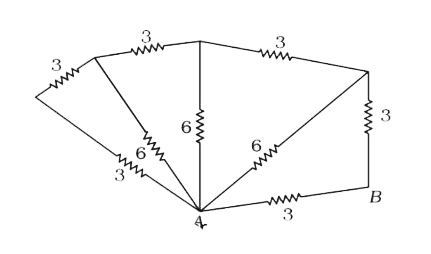State and explain Ohm.s law and hence defined one ohm.
Step-by-Step Solution:
1. State Ohm's Law:
Ohm's Law states that the potential difference (V) across a conductor is directly proportional to the current (I) flowing through it, provided that the temperature and other physical conditions remain constant. This relationship can be mathematically expressed as:
V∝I
2. Mathematical Expression:
To remove the proportionality sign, we introduce a constant of proportionality, which is the resistance (R) of the conductor. Thus, Ohm's Law can be rewritten as:
V=I⋅R
Here, V is the voltage (potential difference), I is the current, and R is the resistance.
3. Define Resistance:
From the equation R=VI, we can see that resistance is defined as the ratio of the voltage across a conductor to the current flowing through it.
4. Define One Ohm:
To define one ohm, we consider the case where a potential difference of 1 volt (V = 1 V) is applied across a conductor, and it results in a current of 1 ampere (I = 1 A) flowing through it. Therefore, we can define one ohm as:
1Ohm=Resistance when V=1Volt \& I=1Ampere
Ohm's Law states that the potential difference (V) across a conductor is directly proportional to the current (I) flowing through it, provided that the temperature and other physical conditions remain constant. This relationship can be mathematically expressed as:
V∝I
To remove the proportionality sign, we introduce a constant of proportionality, which is the resistance (R) of the conductor. Thus, Ohm's Law can be rewritten as:
V=I⋅R
Here, V is the voltage (potential difference), I is the current, and R is the resistance.
From the equation R=VI, we can see that resistance is defined as the ratio of the voltage across a conductor to the current flowing through it.
To define one ohm, we consider the case where a potential difference of 1 volt (V = 1 V) is applied across a conductor, and it results in a current of 1 ampere (I = 1 A) flowing through it. Therefore, we can define one ohm as:
1Ohm=Resistance when V=1Volt \& I=1Ampere
Similar Questions
Knowledge Check
Ohm.s law in vector form is :
AV=I.RB→j=σ→EC→E=σ→jD→j=σ→E
State and explain the second law of thermodynamics.
View SolutionState and explain Boyle's law. Represent the law graphically.
View SolutionState Ohm' law and deduce it from the knowledge of drift velocity of free electrons in a conductor carrying current.
View SolutionState Ohm's law. How can it be verified experimentally ? Explain with the help of a circuit diagram. Express the result graphically.
View SolutionAll resistance in the diagram are in ohm
Find the effective resistance (in ohm) between the points A and B

View SolutionState and explain the pressure-temperature law.
View SolutionState the physical condition in which Ohm.s law is not valid for a conductor.
View Solution

